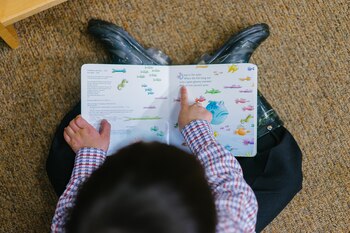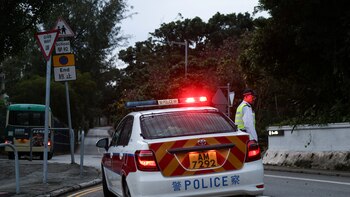
Several studies have shown that parents agree that they are right if they suspect that their child has a problem for 85% of the time. You may not know the name of this object you are observing, but it is generally not wrong to assume that something will happen.
“For a person to be diagnosed with Autism Spectrum Disorder or Autism Spectrum Disorder (ASD), it is necessary to observe communication failures, social skills failures, and behavioral failures.” Faculty of Psychology at UBA Ana D'Anna, Doctor of Psychology and Director of Practical Affairs. “These difficulties arise in different ways and to different degrees for each subject, so two people with the same diagnosis can have different characteristics.” He added.
On the other hand, Dr. Alejandro Anderson, neurologist and director of the Buenos Aires Institute of Neurology (INBA), when consulted with Infobae, stated that ASD “is a neurodevelopmental state associated with everything related to the growth and maturation of the brain, which compromises the way a person perceives, behaves, thinks, and socializes with others. This causes problems in social interaction and communication, and, of course, the disorder will include very characteristic behavioral patterns that are limited and repetitive.”
This condition affects the nervous development of the child, which means that its characteristics, clinical manifestations are observed in the early stages of evolution in the early stages of development.
Dr. D'Anna emphasized that the type of research that detects ASD depends on the age and situation of the child concerned. “It is not the same to detect indicators in children between 0 and 3 years of age, for which the behavior repertoire is determined; It is not the same to detect them than in other contexts, such as the psychologist's office personally, in the context of pediatric counseling.”
For professionals, the training that professionals should receive about ASD is very important. “It is difficult for a specialist to diagnose what is not in the mental map, so the person who is committed to it must be very clear and well studied: the characteristics that represent these children and also the great diversity that exists from one child to another, and therefore the manifestation of symptomatic symptoms.”
On the other hand, Andersson emphasized that the intensity and quality of autism spectrum disorders vary greatly. “We need to observe the patient. It is necessary to make a very good interrogation about how the patient's development has been and how it has changed over time. You have to ask about interactions and social skills.” He explained.
He also emphasized the importance of implementing tests that measure hearing, language, and developmental levels and measure social abilities and behaviors. “In this regard, it is very interesting and very positive that a new tool has appeared to detect autism much earlier.
New tools to detect ASD
A study conducted by Victoria on more than 13,500 children over a five-year period found a tool for early detection of autism that could detect autism three years earlier than conventional tools. It was published on the JAMA Network Open, developed by researchers from the University of La Trobe, Australia, and is already used in more than 11 countries.
The study concluded that SACS-R is highly accurate in identifying very young children in the autism spectrum. 83% of infants from 12 to 24 months reported by this tool were diagnosed with autism.
SACS - When used in conjunction with preschool screening, 3.5 percent of children with autism spectrum were identified in a 6-year screening. Medical professionals from 10 countries around the world, including China, Singapore, Poland, Japan, New Zealand, Nepal, and Bangladesh, were also trained in the use of this tool.
Early diagnosis of autism is essential because it not only provides early access to support, services, and treatment, but also improves developmental outcomes, increases participation in mainstream schools, and reduces the support needed as children grow. The SACS-R tool addresses the problem of poor accuracy of autism screening tools with an accuracy level of 6%.
Often, “parents are instructed to wait and act when they are concerned about their child's development, which means that the average age of diagnosis is about 4 to 5 years, which means that the opportunity for early assistance is lost.” “, experts warned.
They also emphasize the importance of leaving this highly effective tool in the hands of medical professionals trained in primary care, so that autism tests can be performed during routine medical examinations, which can make a big difference in early diagnosis.
Josephine Barbaro, senior researcher and associate professor at the Olga Autism Research Center, points to an important need for SACS-R and SACS-kindergarten to spread in Australia and around the world, as part of regular health screenings in infants, Tennyson (OTAC) at La Trobe University.
According to Vice Chancellor La Trobe, Professor John Dewar, this screening tool is “a great example of high-impact research that can make a real difference in people's lives” and “identifying autism early using this tool has already changed the lives of thousands of people. Children and their families around the world”.
With the remarkable contribution of autism experts from La Trobe, this new study will lead more countries to adopt this tool and integrate screening programs into their health systems.
The revised Social Work and Communication Surveillance (SACS-R) and SACS-Preschool (SACS-PR) tools, developed by Professor Barbaro for more than 15 years, are used to identify a series of behaviors characteristic of children over 11 months, including the rare or inconsistent use of gestures such as: pointing at greetings and objects, calling names, eye contact, imitating or copying other people's activities, sharing interests with others, or pretending to play.
Signs to be alerted
“Because there are more plastic brains, they are much more likely to generate strategies to compensate for brain failures in autistic patients,” Andersson said. I emphasized that.
The behavior to be attended is related to the chronological age of the child.D'Anna said: “International consensus agrees that eye contact is one of the warning signs and the first indicator of the social aspect of communication.
“Social smile, the appearance of gestures such as regaining a smile, responding to his name, throwing a kiss, saying goodbye with his hand, pointing gestures,” he explained. Other signs to keep in mind are the appearance of imitation, the first words of a one-year-old baby, sharing interest, and gestures that bring something to share.
Of course, “the loss of a child's ability to speak and stop talking is always present; these are all behaviors that we must pay attention to and that we should not overlook or minimize.” “, concludes D'Anna.
The two experts consulted by Infobae agreed that the faster and earlier the diagnosis was made, the more important it is, since treatment can be started immediately.
Keep reading:
Últimas Noticias
Debanhi Escobar: they secured the motel where she was found lifeless in a cistern
Members of the Specialized Prosecutor's Office in Nuevo León secured the Nueva Castilla Motel as part of the investigations into the case

The oldest person in the world died at the age of 119
Kane Tanaka lived in Japan. She was born six months earlier than George Orwell, the same year that the Wright brothers first flew, and Marie Curie became the first woman to win a Nobel Prize

Macabre find in CDMX: they left a body bagged and tied in a taxi
The body was left in the back seats of the car. It was covered with black bags and tied with industrial tape
The eagles of America will face Manchester City in a duel of legends. Here are the details
The top Mexican football champion will play a match with Pep Guardiola's squad in the Lone Star Cup

Why is it good to bring dogs out to know the world when they are puppies
A so-called protection against the spread of diseases threatens the integral development of dogs




